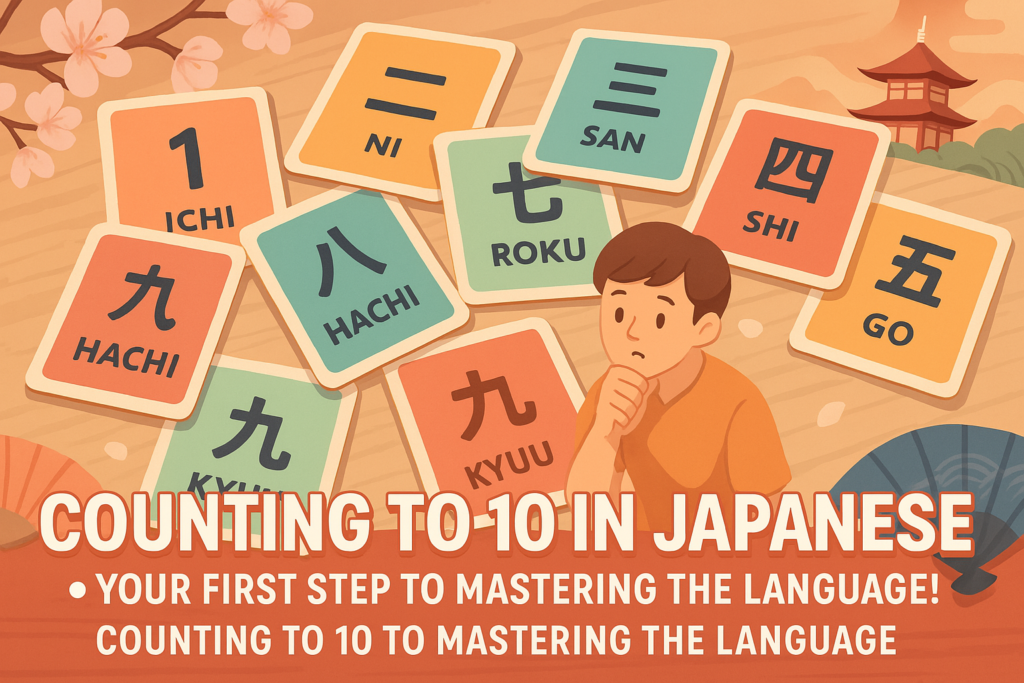Are you taking your first steps into learning Japanese? Mastering how to count to 10 in Japanese is the perfect place to start! This fundamental skill will help you navigate everyday situations, from shopping to telling time, and serves as a building block for more advanced Japanese language learning.
Why Learning Japanese Numbers Is Essential
Learning to count in Japanese isn’t just about memorizing numbers—it opens doors to understanding Japanese culture, reading signs, making purchases, and engaging in basic conversations. Whether you’re planning a trip to Japan, watching anime, or simply expanding your language skills, counting to 10 in Japanese is a crucial first step.
As we explore in our guide to perfect Japanese introductions, even basic number knowledge can significantly improve your ability to connect with Japanese speakers and navigate daily life in Japan.
The Basics: Counting to 10 in Japanese
Let’s dive right into the essential numbers from 1 to 10 in Japanese:
| Number | Hiragana | Romaji | Kanji |
|---|---|---|---|
| 1 | いち | ichi | 一 |
| 2 | に | ni | 二 |
| 3 | さん | san | 三 |
| 4 | よん/し | yon/shi | 四 |
| 5 | ご | go | 五 |
| 6 | ろく | roku | 六 |
| 7 | なな/しち | nana/shichi | 七 |
| 8 | はち | hachi | 八 |
| 9 | きゅう/く | kyuu/ku | 九 |
| 10 | じゅう | juu | 十 |
You might notice that some numbers have two ways to read them. Don’t worry—we’ll explain when to use each pronunciation!
Pronunciation Tips for Counting to 10 in Japanese
When counting to 10 in Japanese, clear pronunciation is key. Here are some tips to help you sound more natural:
- いち (ichi): Pronounce it as “ee-chee” with equal stress on both syllables
- に (ni): Say “nee” with a slightly longer vowel sound
- さん (san): Pronounce it like “sahn” with a clear “a” sound
- よん (yon): Say “yohn” with a rounded “o” sound
- ご (go): Pronounce it like “goh” with a longer “o” sound
- ろく (roku): Say “roh-koo” with equal stress
- なな (nana): Pronounce it as “nah-nah” with equal emphasis
- はち (hachi): Say “hah-chee” with a clear “h” sound
- きゅう (kyuu): Pronounce it as “kyoo” with a long “oo” sound
- じゅう (juu): Say “joo” with a longer “oo” sound
Want to explore Japan’s culture?
Discover Japan’s rich culture, traditions, and hidden gems with our expertly crafted guides. Get insider tips on travel, food, and history. All for free!
When to Use Different Pronunciations
As you may have noticed, some Japanese numbers have alternative pronunciations:
- 4: よん (yon) is generally preferred over し (shi) because し sounds similar to 死 (shi), which means “death” (considered unlucky)
- 7: なな (nana) is commonly used in counting, while しち (shichi) appears in compounds
- 9: きゅう (kyuu) is standard, though く (ku) appears in some contexts
As we explain in our guide to Japanese filler words, these pronunciation variations are part of what makes Japanese conversations sound natural and fluent.
Practice Counting to 10 in Japanese
To really master counting to 10 in Japanese, practice is essential. Try these exercises:
- Count aloud daily: Spend just 1-2 minutes counting from 1-10 in Japanese each day
- Use number flashcards: Create simple flashcards with numbers on one side and Japanese on the other
- Associate with gestures: Use finger counting while saying each number
- Incorporate into daily life: Count everyday objects in Japanese
- Record yourself: Compare your pronunciation with native speakers
Real-Life Applications for Japanese Numbers 1-10
Once you’ve mastered counting to 10 in Japanese, you can use these numbers in various practical situations:
- Shopping: Asking for quantities (例: りんごを三つください。- Ringo o mittsu kudasai. – Three apples, please.)
- Time: Telling time (例: 七時です。- Shichi-ji desu. – It’s seven o’clock.)
- Phone numbers: Understanding and communicating phone numbers
- Addresses: Many Japanese addresses include numbers
- Ordering food: Specifying quantities when ordering
Similar to how “wakaru” (to understand) helps you grasp concepts as explained in our wakaru meaning guide, counting to 10 in Japanese helps you understand the foundation of Japanese numerical expressions.
Cultural Significance of Numbers in Japanese
In Japanese culture, certain numbers carry special significance:
- 4 (四): Considered unlucky because its pronunciation し (shi) sounds like 死 (death)
- 7 (七): Considered lucky, similar to Western cultures
- 8 (八): Associated with prosperity because the kanji 八 widens as it’s written
- 9 (九): Sometimes considered unlucky as く (ku) can sound like 苦 (suffering)
Understanding these cultural nuances adds depth to your language learning journey.
Moving Beyond 10: Next Steps
Once you’ve mastered counting to 10 in Japanese, you’re ready to expand your numerical vocabulary:
- Learn numbers 11-20, which follow a pattern (11 is じゅういち, juu-ichi, literally “10-1”)
- Discover Japanese counter words for different objects
- Practice telling time in Japanese
- Learn how to say years, dates, and prices
Ready to continue your Japanese language journey? Visit our Learn Japanese page for free guides to help you progress further.
Q&A: Quick Facts About Counting to 10 in Japanese
Q: What is the Japanese word for the number 1? A: The Japanese word for the number 1 is “ichi” (いち).
Q: Why does the number 4 have two pronunciations in Japanese? A: Number 4 has two pronunciations—よん (yon) and し (shi)—because し sounds like the word for death, making it considered unlucky in many contexts.
Q: How do Japanese children learn to count? A: Japanese children often learn counting through songs, finger games, and counting objects, similar to children in other cultures.
Q: Are Japanese numbers different from Chinese numbers? A: Japanese kanji numbers were adopted from Chinese, but their pronunciation differs significantly.
Q: Is counting to 10 in Japanese difficult for beginners? A: Counting to 10 in Japanese is relatively straightforward and is considered one of the easiest parts of basic Japanese to master.
Learning to count to 10 in Japanese is your gateway to Japanese language mastery. With regular practice and these helpful tips, you’ll be counting confidently in no time!
Love Japan? Stay in the Loop!
Get the best of Japan straight to your inbox: language, culture & travel insights!




